Making Rugelach
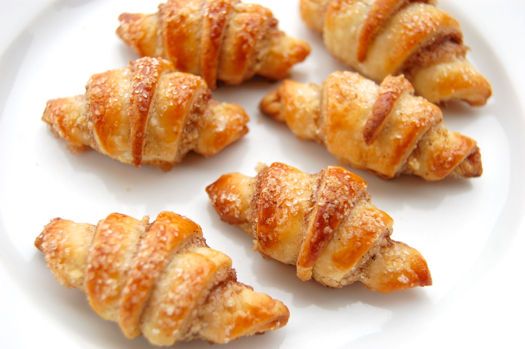
I like to make rugelach in the shape of croissants because it’s very likely that rugelach were modeled on croissants. Or the other way around, it’s hard to say. What’s true is that croissants, rugelach and kipfel are all members of the same pastry family, and none of them have anything to do with the Battle of Vienna.
These are cream cheese short pastry rugelach, just one of several possible styles. They’re a bit fussy to make but worth the results. And anyway after the first dozen or so the shaping process will become so automatic you’ll scarcely know you even doing it. This recipe makes either 24 or 32, but can easily be scaled up if you like. Start by combining the butter and cream cheese in the bowl of a mixer fitted with a paddle.
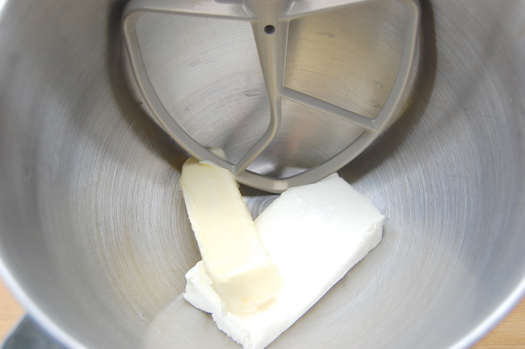
Beat that about 30 seconds on medium-high until it’s light and fluffy, then add the sugar, salt and vanilla. A little lemon zest might work well here too if you feel like gettin’ jiggy widdit, as Will Smith might have said if here we making rugelach back in the 90’s.
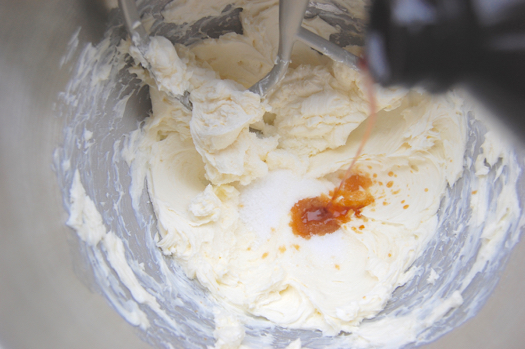
Beat another 15 seconds or so, scrape the bowl and then with the machine on low start adding the flour.
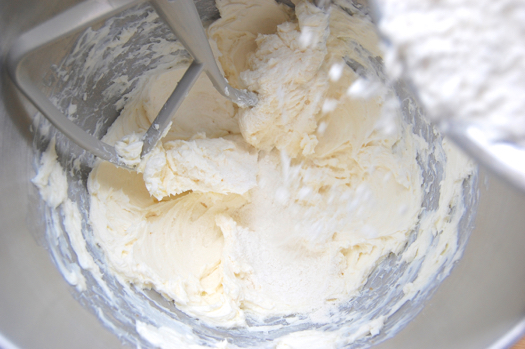
Stir only until it’s barely incorporated and the dough is clumpy.
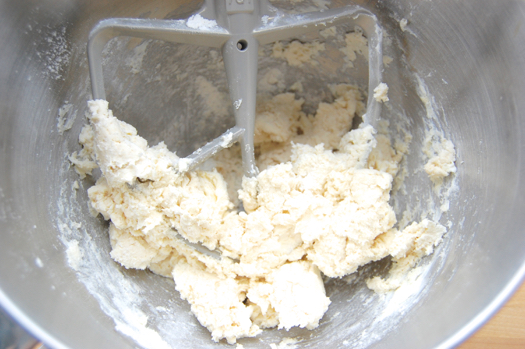
Remove the dough to a lightly floured board, gather the dough together, then divide the mass into two pieces. Shape each one into a ball. Wrap those in plastic and let them sit in the refrigerator for a minimum of an hour, or keep it there for up to 3 days.
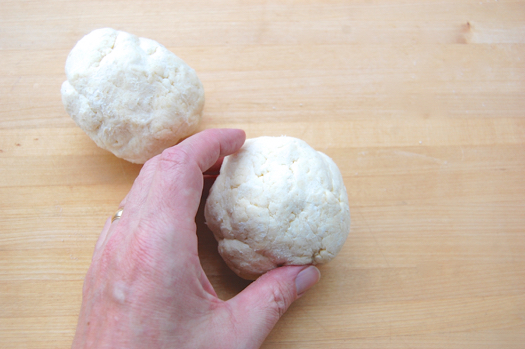
When you’re ready to shape preheat your oven to 400 degrees Fahrenheit. Remove the dough from the fridge and let it sit about 15 minutes to warm up and soften. Remove one of the dough pieces to a well-floured board. Pat it into a disk and apply the pin to it.
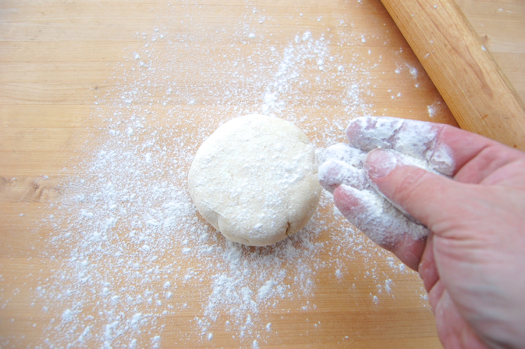
If when you start rolling you get a big crack like this, let the dough sit another five minutes. Press the crack together and try rolling again. The dough should warm enough to the point that it rolls out easily.

Roll it out to a circle about 11″ across. Check it frequently as you roll to make sure it’s not sticking to the board. If it is, throw more flour under it. You want your finished dough roughly circular. If it isn’t just trim it up a little. Don’t go nuts with precision, this isn’t an exact science.
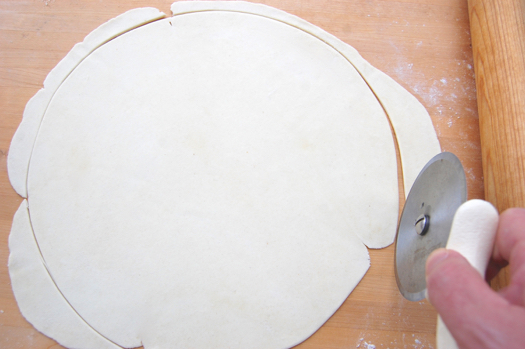
Now using a pizza cutter cut the dough sheet into quarters.
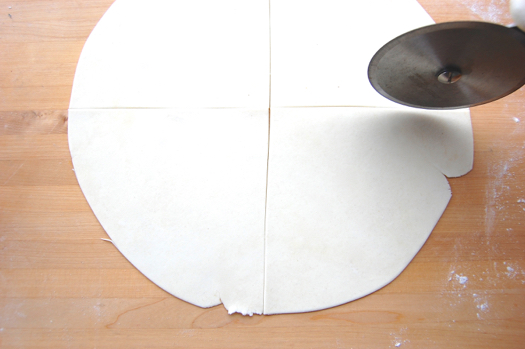
For 16 small rugelach, cut the dough into eighths, then into sixteenths. For slightly larger rugelach, cut each quarter into thirds. I like to cut before I put toppings on so I don’t get confused about where my lines are. Except when I’m applying jam, then I spread it on first.
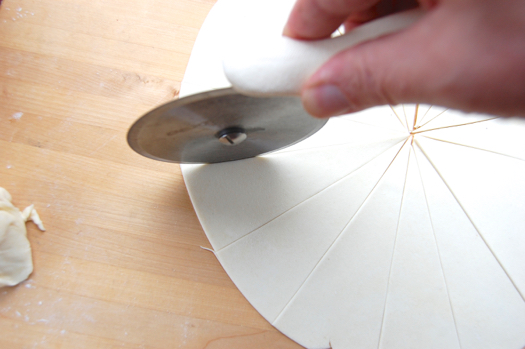
Now then for the toppings. For fine toppings like cinnamon or chocolate sugar, you can just spread them all over. Try to avoid the very center, which I forgot to do here.
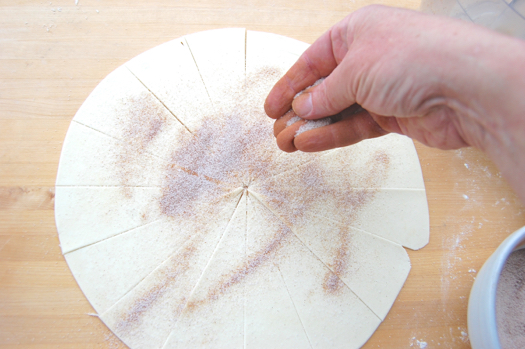
Chunky fillings should be applied in a ring in the middle. Here I have some finely chopped walnuts.
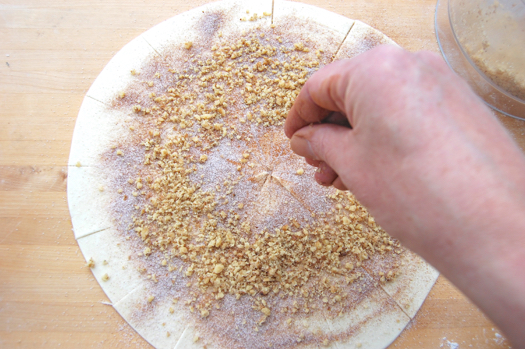
As I mentioned at the beginning, I like to shape mine just like croissants, so I use the same rolling process. I stretch the triangle out, which makes a more graceful-looking roll.
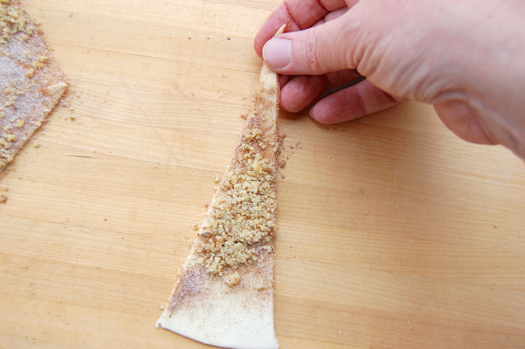
I moisten the very tip with a little water or egg wash.
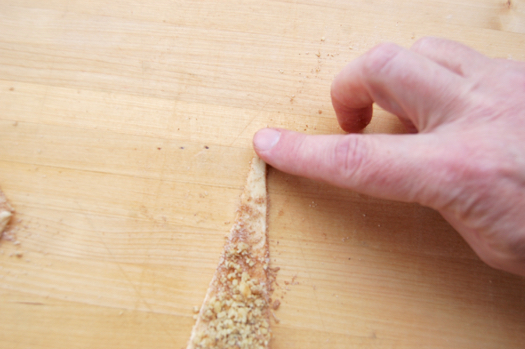
Then I cut a little slit in the center of the fat end to give me a little extension.

I pull the slit apart…
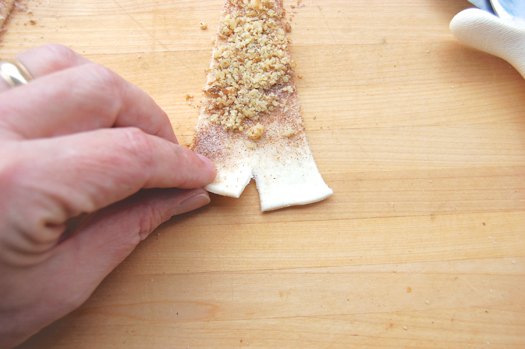
…and start rolling the triangle up.

Until she eez done. See?
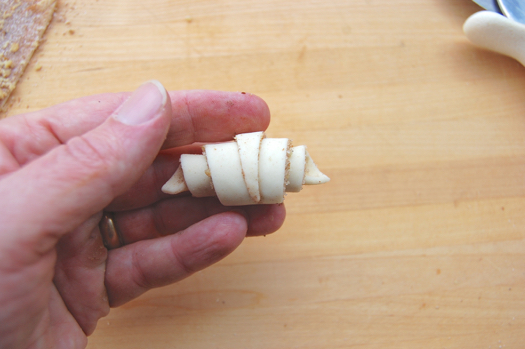
I lay those out on a sheet pan…
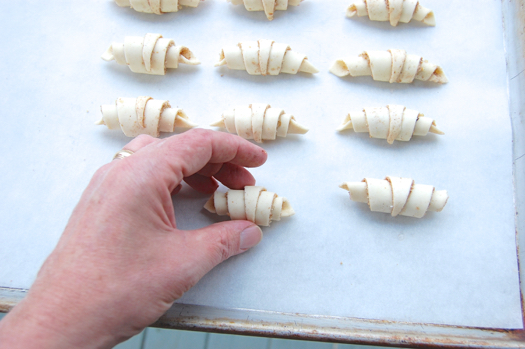
…then paint them with a little egg wash. Since I’m more comfortable brushing with my right hand, I paint outward from the center on each, then I rotate the sheet pan180 degrees and do the other sides, if that makes sense.
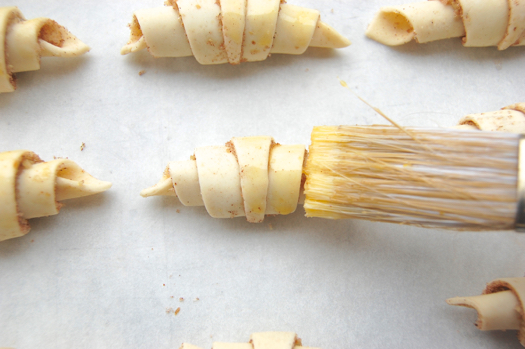
Lastly I apply a little white large-crystal dusting sugar for added crunch.
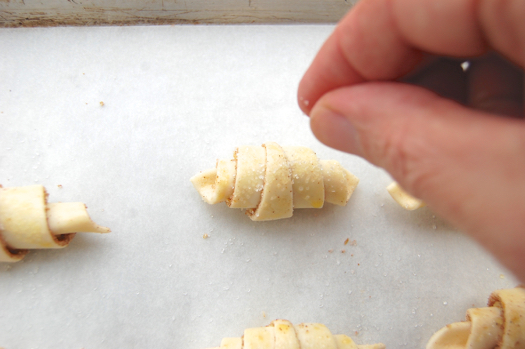
I bake those suckers for 20-30 minutes (25-35 for larger rugelach) until they’re golden.

Serve them warm if you like as they are darn tasty that way.
They look amazing! Egg wash and coarse sugar, I should remember that, it makes all the difference.
Thanks, Sonya! Let me know how yours turn out!
– Joe
Hmm, yours look really beautiful, but for some reason when I made them (and all other rugelach I have tried to make over the years) they turn out sort of less beautiful. I have no trouble making croissants, so what’s up with rugelach-rolling that is so challenging?
Hey James!
First, thanks! But let’s see…if yours are turning out less beautiful than you’d like, where do you think the process is going wrong? Is the dough too stiff? That’s where a lot of rugelach makers run into problems. That and not enough flour on the board. Could either of those be the issue do you think?
– Joe
Could you please comment on the “strudel” shape? I’ve tried making rugelach twice before and I’ve failed twice. I seem to make the roll way too thick which then leads me to cut the slices just a liiiiitle too thin–otherwise they’d be way too huge with how tall the roll is. So I cut them about an inch, inch and a half thick, and they seem plenty thick enough to stand up by themselves just fine when they go in the oven, but then they seem to melt into sad puddles that almost want to be mini-cinnamon rolls. I tried getting the dough into a shorter, squatter rectangle too and this still seems to happen. What is the proper rectangle size to use for the “strudel” shape? This way I can have a ruler next to the dough…
Hello Justine!
Yes I can understand that. You’ll find this dough to be very forgiving. Once it’s warmed up it rolls out easily, and can be rolled very thin. I’d shoot for a square that’s about 12 inches wide and 6-7 inches long. If you can go larger and feel comfortable doing it, roll a little more. You’ll want to get about 12 pieces or so, the longer you make the sheet the more layers you’ll have and the flakier the rugelach will be.
Good luck!
– Joe
LOVE the technique of nipping the long edge to create more flair! I would NEVER have figured that out.
You are a wonder and I’m so grateful I ran across your site lo these years.
Very merry and very delicious to the Pastries!
Ha! Thanks, Rainey!
You’re a blessing to me as a reader! All the best to you and your this season!
– Joe
Beautiful rugelach. I’m making them for a Sunday Hanukkah gathering.
Just FYI, your original recipe says to add the filling before slicing the dough into sections:
“Apply your filling to the circle … Press the filling into the dough … Next using a pizza cutter, cut the dough …”
(It works much better as you show in the photos. It also makes rolling easier if you leave the center empty of filling.)
Oops…thanks, I’ll correct that.
And I was wondering if/when you’d say anything about the finished rugelach. Thank you, now I can declare them an official success! 😉
Cheers,
– Joe
PS – I’m especially impressed with how beautifully they browned.
Thanks, Chana! It’s that egg wash…does it every time!
– Joe
Thanks for the shaping and filling tips. I like the crescent rugelach too but they always come out malformed and irregularly sized when I make them. I’ll try your advice next time and let you know.
Please tell me how they go, nbm!
Cheers,
– Joe
Beautiful, 🙂
Thanks, Dani!
– Joe
??? – Joe, can these be frozen, formed, before baking? I suspect they can, but I need your opinion.
Thanks.
Susan
GREAT point Susan and I meant to mention that. They absolutely can be frozen after shaping (before the application of egg wash) for up to three months.
Thanks,
– Joe
I have a quick question…. First off, I never made rugelach in my life and after researching many recipes yours seems the simplest and looks the most delicious 🙂 I would really love to make a chocolate rugelach, but I don’t know what kind of chocolate or cocoa to use to make my rugelach as scrupcious as yours. Can you please tell me and what the measurements are?? Thanks!
Hey Barbara-Anne!
There are some ideas posted with the recipe, but suffice to say a mixture 3-1 mixture of sugar and a good quality cocoa powder works great spread across the dough like the cinnamon sugar. Supplement that with a few chocolate chips if you really want to put them over the top.
Cheers and have fun!
– Jim
Filling options? Cinnamon & Brown Sugar seems like an easy choice… homemade jam would be good, but probably not as pretty. Other good choices, perhaps finely chopped dried fruits, maybe in a little simple syrup?
Topping, instead of the large crystal sugar, how about a drizzle of white icing (like on a danish)?
I may have to make a batch or three for a Christmas gathering, since they are so pretty – best to prep and bake there (hour and a half drive) or bake and reheat?
So I cranked out two batches of these last night – cinnamon sugar inside, and I couldn’t find large grain sugar for a topping so I went with a plain vanilla icing (powdered sugar, water, dash of vanilla extract). They came out a-ma-zing. The time involved was more than, say, a coffee cake – but the payoff is worth it.
Thanks Joe! I’m going to incorporate this one into the rotation!
Woohoo!
Nice improvisation. I bet those were spectacular. And yes, they are a little time consuming. Back at the bakery we production guys would always sigh heavily when a large rugelach order came in. Working late tonight!
Cheers and thanks for the update!
– Joe
Bake and reheat, definitely.
– Joe
Joe,
I’ve seen that some people give their dough a three fold before rerolling their dough. Is this necessary and does it really change anything because the dough is already a homogenous mass.
Hi Tom!
I’ve never seen that, but I’m with you. My guess is that it would produce a somewhat flakier — if tougher — crust. Tough because the extra working will activate some gluten. Also you point out the dough would compress into something mostly homogenous anyway. I’m skeptical, but if you try it please get back to me with the results.
– Joe
The rolling a circle, cutting, and filling is so simple and smart! I can’t believe this is the first time I’ve seen that. The next time I make croissants (I like them on the smaller side, I’m not a fan of huge ones), or really any crescent-shaped item, I’m definitely doing it that way. Thanks for the tip!
These look awesome! I’ve never seen them in the UK. Might have to whip up a batch after the Christmas madness has dissipated.
Thanks, Alison!
And please do get back to me with the results!
– Joe
I did it! I made them and they are great. So easy to do, even with children!
Woohoo!
Thanks, Alison!
– Joe